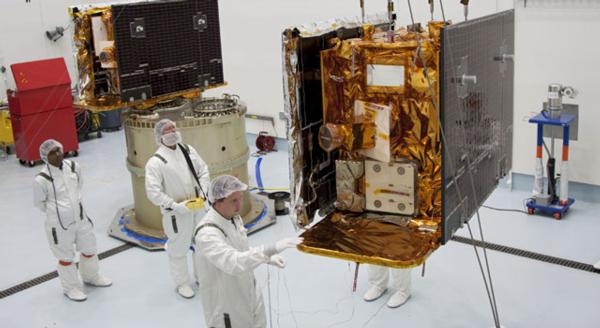Mon, Aug 29, 2011
Delta II Rocket Set To Boost The Satellites Towards The Moon
September 8th
NASA's Gravity Recovery And Interior Laboratory (GRAIL), mission
to study the moon is in final launch preparations for a scheduled
September 8 launch onboard a Delta II rocket from Cape Canaveral
Air Force Station in Florida. GRAIL's twin spacecraft are tasked
for a nine-month mission to explore Earth's nearest neighbor in
unprecedented detail. They will determine the structure of the
lunar interior from crust to core and advance our understanding of
the thermal evolution of the moon.

"Yesterday's (Thursday's) final encapsulation of the spacecraft
is an important mission milestone," said David Lehman, GRAIL
project manager for NASA's Jet Propulsion Laboratory in Pasadena,
Calif. "Our two spacecraft are now sitting comfortably inside the
payload fairing which will protect them during ascent. Next time
the GRAIL twins will see the light of day they will be about 95
miles up and accelerating."
The spacecraft twins, GRAIL A and B, will fly a circuitous route
to lunar orbit taking 3.5 months and covering approximately 2.6
million miles (4.2 million kilometers) for GRAIL-A, and 2.7 million
miles (4.3 million kilometers) for GRAIL-B. In lunar orbit, the
spacecraft will transmit radio signals precisely defining the
distance between them. Regional gravitational differences on the
moon are expected to expand and contract that distance. GRAIL
scientists will use these accurate measurements to define the
moon's gravity field. The data will allow mission scientists to
understand what goes on below the surface of our natural satellite.
"GRAIL will unlock lunar mysteries and help us understand how the
moon, Earth and other rocky planets evolved as well," said Maria
Zuber, GRAIL principal investigator from the Massachusetts
Institute of Technology in Cambridge.
GRAIL's launch period opens September 8 and extends through
October 19. On each day, there are two separate launch
opportunities separated by approximately 39 minutes.
More News
Aero Linx: Model Aeronautical Association of Australia MAAA clubs are about fun flying, camaraderie and community. For over 75 years, the MAAA has been Australia’s largest fl>[...]
Touchdown Zone Lighting Two rows of transverse light bars located symmetrically about the runway centerline normally at 100 foot intervals. The basic system extends 3,000 feet alon>[...]
“Discovery and innovation are central to our mission at Virgin Galactic. We’re excited to build on our successful record of facilitating scientific experiments in subor>[...]
How To Get A Story On Aero-TV News/Feature Programming How do I submit a story idea or lead to Aero-TV? If you would like to submit a story idea or lead, please contact Jim Campbel>[...]
Student Pilot Reported That During Rotation, “All Of A Sudden The Back Of The Plane Kicked To The Right..." Analysis: The student pilot reported that during rotation, “>[...]
 ANN's Daily Aero-Linx (05.02.24)
ANN's Daily Aero-Linx (05.02.24) ANN's Daily Aero-Term (05.02.24): Touchdown Zone Lighting
ANN's Daily Aero-Term (05.02.24): Touchdown Zone Lighting Aero-News: Quote of the Day (05.02.24)
Aero-News: Quote of the Day (05.02.24) ANN FAQ: Contributing To Aero-TV
ANN FAQ: Contributing To Aero-TV NTSB Final Report: Cirrus Design Corp SR20
NTSB Final Report: Cirrus Design Corp SR20



